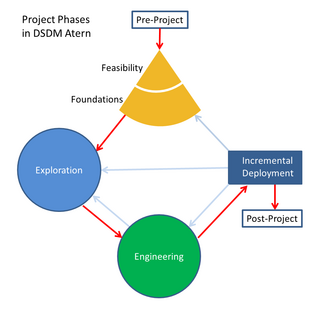Related Research Articles
In software development, agile practices include requirements discovery and solutions improvement through the collaborative effort of self-organizing and cross-functional teams with their customer(s)/end user(s), Popularized in the 2001 Manifesto for Agile Software Development, these values and principles were derived from and underpin a broad range of software development frameworks, including Scrum and Kanban.

Dynamic systems development method (DSDM) is an agile project delivery framework, initially used as a software development method. First released in 1994, DSDM originally sought to provide some discipline to the rapid application development (RAD) method. In later versions the DSDM Agile Project Framework was revised and became a generic approach to project management and solution delivery rather than being focused specifically on software development and code creation and could be used for non-IT projects. The DSDM Agile Project Framework covers a wide range of activities across the whole project lifecycle and includes strong foundations and governance, which set it apart from some other Agile methods. The DSDM Agile Project Framework is an iterative and incremental approach that embraces principles of Agile development, including continuous user/customer involvement.
In agile principles, timeboxing allocates a maximum unit of time to an activity, called a timebox, within which a planned activity takes place. It is used by agile principles-based project management approaches and for personal time management.
Lean software development is a translation of lean manufacturing principles and practices to the software development domain. Adapted from the Toyota Production System, it is emerging with the support of a pro-lean subculture within the agile community. Lean offers a solid conceptual framework, values and principles, as well as good practices, derived from experience, that support agile organizations.
Agile modeling (AM) is a methodology for modeling and documenting software systems based on best practices. It is a collection of values and principles that can be applied on an (agile) software development project. This methodology is more flexible than traditional modeling methods, making it a better fit in a fast-changing environment. It is part of the agile software development tool kit.

Scrum is an agile team collaboration framework commonly used in software development and other industries.

Jeff Sutherland is one of the creators of Scrum, a framework for product management. Together with Ken Schwaber, he presented Scrum at OOPSLA'95. Sutherland contributed to the creation of the Agile Manifesto in 2001. Along with Ken Schwaber, he wrote and maintains The Scrum Guide, which contains the official definition of the framework.
Agile testing is a software testing practice that follows the principles of agile software development. Agile testing involves all members of a cross-functional agile team, with special expertise contributed by testers, to ensure delivering the business value desired by the customer at frequent intervals, working at a sustainable pace. Specification by example is used to capture examples of desired and undesired behavior and guide coding.

Follow the Sun (FTS), a sub-field of globally distributed software engineering (GDSE), is a type of global knowledge workflow designed in order to reduce the time to market, in which the knowledge product is owned and advanced by a production site in one time zone and handed off at the end of their work day to the next production site that is several time zones west to continue that work. Ideally, the work days in these time zones overlap such that when one site ends their day, the next one starts.
In software engineering, a software development process is a process of planning and managing software development. It typically involves dividing software development work into smaller, parallel, or sequential steps or sub-processes to improve design and/or product management. It is also known as a software development life cycle (SDLC). The methodology may include the pre-definition of specific deliverables and artifacts that are created and completed by a project team to develop or maintain an application.
A programming team is a team of people who develop or maintain computer software. They may be organised in numerous ways, but the egoless programming team and chief programmer team have been common structures.
ScrumEdge is a collaborative web-based scrum tool that allows agile development teams, ScrumMasters, and stakeholders to manage the Scrum lifecycle at the product and sprint levels.
Specification by example (SBE) is a collaborative approach to defining requirements and business-oriented functional tests for software products based on capturing and illustrating requirements using realistic examples instead of abstract statements. It is applied in the context of agile software development methods, in particular behavior-driven development. This approach is particularly successful for managing requirements and functional tests on large-scale projects of significant domain and organisational complexity.
Agile Business Intelligence (BI) refers to the use of Agile software development for BI projects to reduce the time it takes for traditional BI to show value to the organization, and to help in quickly adapting to changing business needs. Agile BI enables the BI team and managers to make better business decisions, and to start doing this more quickly.

Extreme programming (XP) is a software development methodology intended to improve software quality and responsiveness to changing customer requirements. As a type of agile software development, it advocates frequent releases in short development cycles, intended to improve productivity and introduce checkpoints at which new customer requirements can be adopted.
Disciplined agile delivery (DAD) is the software development portion of the Disciplined Agile Toolkit. DAD enables teams to make simplified process decisions around incremental and iterative solution delivery. DAD builds on the many practices espoused by advocates of agile software development, including scrum, agile modeling, lean software development, and others.
eXtreme Manufacturing (XM) is an iterative and incremental framework for manufacturing improvement and new product development that was inspired by the software development methodology Scrum and the systematic waste-elimination (lean) production scheduling system Kanban(かんばん ).
A distributed development project is a research and development (R&D) project that is done across multiple business worksites or locations. It is a form of R&D where the project members may not see each other face to face, but they are all working collaboratively toward the outcome of the project. Often this is done through email, the Internet and other forms of quick long-distance communication. Distributed development was largely pioneered by the open-source software community.
The scaled agile framework (SAFe) is a set of organization and workflow patterns intended to guide enterprises in scaling lean and agile practices. Along with disciplined agile delivery (DAD), SAFe is one of a growing number of frameworks that seek to address the problems encountered when scaling beyond a single team.
Communication in Distributed Software Development is an area of study that considers communication processes and their effects when applied to software development in a globally distributed development process. The importance of communication and coordination in software development is widely studied and organizational communication studies these implications at an organizational level. This also applies to a setting where teams and team members work in separate physical locations. The imposed distance introduces new challenges in communication, which is no longer a face to face process, and may also be subjected to other constraints such as teams in opposing time zones with a small overlap in working hours.
References
- ↑ Jiménez, M., Piattini, M., & Vizcaíno, A. (2009). Challenges and improvements in distributed software development: A systematic review. *Advances in Software Engineering*, *2009*.
- ↑ Prikladnicki, R., Damian, D., & Audy, J. L. N. (2008, June). Patterns of evolution in the practice of distributed software development: quantitative results from a systematic review. In *12th International Conference on Evaluation and Assessment in Software Engineering (EASE) 12* (pp. 1-10)
- ↑ Fowler, M., & Highsmith, J. (2001). The agile manifesto. Software Development, 9(8), 28-35.
- ↑ Ramesh, B., Cao, L., Mohan, K., & Xu, P. (2006). Can distributed software development be agile?. Communications of the ACM, 49(10), 41-46.
- ↑ Razavi, A. M., & Ahmad, R. (2014, September). Agile development in large and distributed environments: A systematic literature review on organizational, managerial and cultural aspects. In 2014 8th. Malaysian Software Engineering Conference (MySEC) (pp. 216-221). IEEE.
- ↑ Ghani, I., Lim, A., Hasnain, M., Ghani, I., & Babar, M. I. (2019). Challenges in Distributed Agile Software Development Environment: A Systematic Literature Review. KSII Transactions on Internet & Information Systems, 13(9).
- ↑ [6] Shrivastava, S. V. (2010). Distributed agile software development: A review. *arXiv preprint arXiv:1006.1955*.
- ↑ Santos, Ronnie de Souza; Ralph, Paul; Arshad, Arham; Stol, Klaas-Jan (5 October 2023). "Distributed Scrum: A Case Meta-Analysis". ACM Computing Surveys. doi: 10.1145/3626519 .
- ↑ M.Paasivaara, S. Durasiewicz, C.Lassenius, Using Scrum in Distributed Agile Development: A Multiple Case Study, IEEE International Conference on Global Software Engineering , p.195-204, 2009
- ↑ Shrivastava, S. V and Date, H. (2010). Distributed Agile Software Development: A Review. Seo-chogu: Journal of computer science and engineering. 10-17
- ↑ "Powerful Factors to Manage Distributed Agile Teams".
- 1 2 Shrivastava, S.V. and Rathod, U., 2014. Risks in distributed agile development: A review. Procedia - Social and Behavioral Sciences, 133, pp.417-424.
- 1 2 Shrivastava, S.V., 2010. Distributed agile software development: A review. arXiv preprint arXiv:1006.1955.
- ↑ M. Fowler, ” Using an Agile Software Process with Offshore development”, http://martinfowler.com/articles/agileOffshore.html, July 2006 (Retrieved on May 11, 2020)
- ↑ Williams, L., Kessler, R.R., Cunningham, W. and Jeffries, R., 2000. Strengthening the case for pair programming. IEEE software, 17(4), pp.19-25
- 1 2 Ade Miller,” Distributed Agile Development at Microsoft patterns and practices”, Microsoft patterns and practices, http://www.pnpguidance.net/Post/DistributedAgile 16 DevelopmentMicrosoftPatternsPractices, October 2008. (retrieved on May 11, 2020)
- ↑ Shrivastava, S. V., & Rathod, U. (2015). Categorization of risk factors for distributed agile projects. *Information and Software Technology*, *58*, 373-387.
- ↑ Pressman, R. S. (2005). *Software engineering: a practitioner's approach*. Palgrave macmillan.
- 1 2 Smits, H. and Pshigoda, G., 2007, August. Implementing scrum in a distributed software development organization. In Agile 2007 (AGILE 2007) (pp. 371-375). IEEE.
- ↑ J. Sutherland, A. Viktorov, J. Blount and N. Puntikov, "Distributed Scrum: Agile Project Management with Outsourced Development Teams," 2007 40th Annual Hawaii International Conference on System Sciences (HICSS'07), Waikoloa, HI, 2007, pp. 274a-274a, doi: 10.1109/HICSS.2007.180.
- 1 2 Hossain, E., Babar, M.A., Paik, H.Y. and Verner, J., 2009, December. Risk identification and mitigation processes for using scrum in global software development: A conceptual framework. In 2009 16th Asia-Pacific Software Engineering Conference (pp. 457-464). IEEE.
- ↑ Holmström, H., Fitzgerald, B., Ågerfalk, P.J. and Conchúir, E.Ó., 2006. Agile practices reduce distance in global software development. Information systems management, 23(3), pp.7-18.
- ↑ Berczuk, S., 2007, August. Back to basics: The role of agile principles in success with a distributed scrum team. In Agile 2007 (AGILE 2007) (pp. 382-388). IEEE.
- ↑ Sutherland, J. (2020, February 28). Distributed Teams: How To Mitigate A Significant Business Risk Of The Coronavirus. Retrieved May 13, 2020, from https://www.scruminc.com/distributed-teams-how-to-mitigate-a-significant-business-risk-of-the-coronavirus/
- ↑ Bose, I., 2008. Lessons learned from distributed agile software projects: A case-based analysis. Communications of the Association for Information Systems, 23(1), p.34.
- ↑ Ramesh, B., Cao, L., Mohan, K. and Xu, P., 2006. Can distributed software development be agile?. Communications of the ACM, 49(10), pp.41-46.